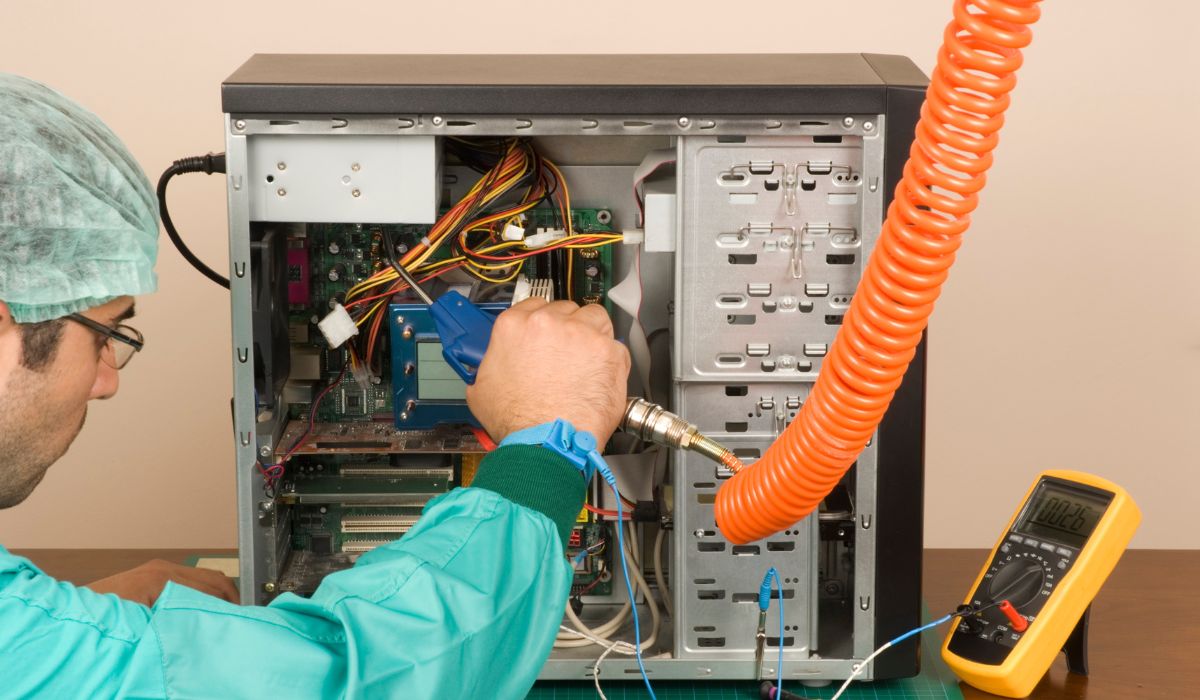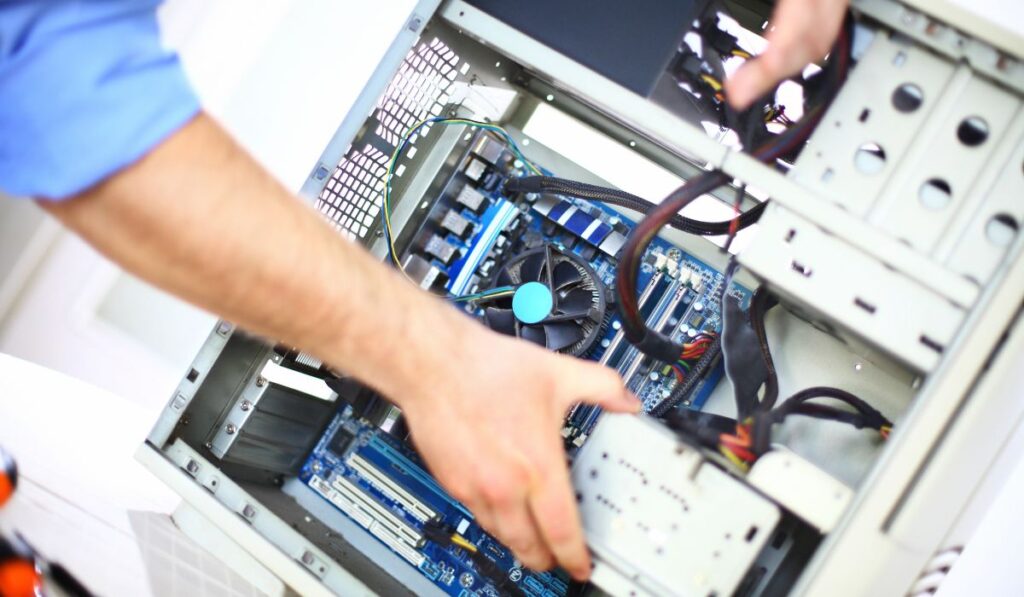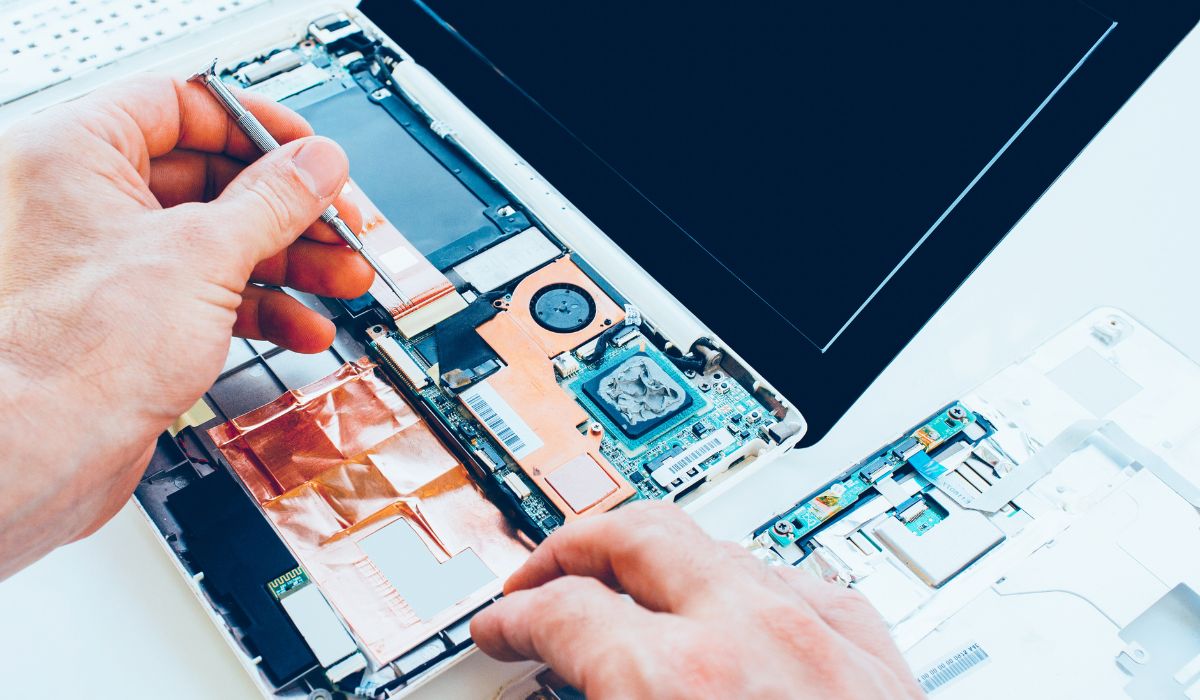Mastering Computer Maintenance: Keep Your PC Running Smoothly
Regular computer maintenance is essential for achieving optimal performance and extending the lifespan of your device. By taking care of your computer, you can ensure it runs smoothly and efficiently. In this article, we will discuss the importance of computer maintenance and provide valuable tips and techniques to help you keep your computer in top shape. From cleaning and software updates to disk cleanup and more, these practices will help you maintain a reliable and high-performing computer for years to come.
Table of Contents
What is Computer Maintenance?
Computer maintenance refers to a set of activities performed to ensure a computer system’s proper functioning and longevity. It involves regular care, cleaning, and optimization to keep the hardware and software components in optimal condition. Computer maintenance includes software updates, disk cleanup, virus scanning, hardware inspection, and system optimization.
By performing these maintenance activities, you can prevent issues, improve performance, enhance security, and extend the lifespan of your computer. It is an essential practice for maintaining the reliability and efficiency of your computer over time.
Computer Maintenance Checklist
Regular computer maintenance is crucial for keeping your system running smoothly and ensuring optimal performance. By following this checklist, you can keep your computer in top shape and minimize the risk of potential issues. Here’s a comprehensive computer maintenance checklist:
- Update Operating System: Keep your operating system up to date by installing the latest updates and patches. This ensures improved security, bug fixes, and compatibility with new software.
- Update Software: Regularly update all installed software, including web browsers, antivirus programs, productivity tools, and multimedia applications. Updated software provides enhanced features, performance improvements, and necessary security patches.
- Run Antivirus Scans: Perform regular scans using reliable antivirus software to detect and remove any malware or viruses that may harm your system.
- Clean Up Disk Space: Regularly remove unnecessary files and free up disk space. Use built-in disk cleanup tools or third-party software to delete temporary files, cache, and old system backups.
- Defragment Hard Drive (if applicable): If you have a traditional hard drive, consider defragmenting it periodically to optimize file storage and improve system responsiveness.
- Organize File System: Maintain a well-organized file structure by creating folders and subfolders for efficient data management. Regularly delete or archive files you no longer need.
- Backup Important Data: Create regular backups of your important files and store them on external drives, cloud storage, or network storage. This protects your data from accidental loss or hardware failures.
- Clean Hardware: Clean the computer’s exterior using a soft cloth and gentle cleaning solution. Use compressed air to remove dust from the keyboard, ports, and fans.
- Check Hardware Connections: Ensure all cables, connectors, and peripherals are securely plugged in. Periodically check and reseat RAM modules, expansion cards, and other internal components.
- Monitor System Temperature: Keep an eye on the computer’s temperature to prevent overheating. Ensure proper airflow, clean dust from fans, and consider using cooling pads or additional fans if needed.
- Remove Unnecessary Startup Programs: Disable or remove unnecessary programs that launch at startup. This helps improve boot time and overall system performance.
- Password Security: Regularly update and strengthen your passwords for user accounts, email, and online services to enhance security.
- Educate Yourself: Stay informed about the latest computer security practices, malware threats, and software updates. Educate yourself on safe browsing habits and avoid clicking on suspicious links or downloading unknown files.
By following this computer maintenance checklist, you can keep your system running smoothly, protect your data, and prolong the lifespan of your computer.
Regular Software Updates and Security
Keeping your computer’s software up to date and implementing effective security measures are crucial for maintaining a safe and protected computing environment. In this section, we will explore the importance of updating the operating system, software, and drivers, as well as implementing essential security practices for safe web browsing and email usage.
Importance of Updating Operating Systems, Software, and Drivers
- Operating System – Regularly updating your operating system is vital for several reasons. Updates often include security patches that address vulnerabilities and protect your system from potential threats. They also deliver performance improvements, bug fixes, and compatibility enhancements with new software and hardware.
- Software – Updating installed software, such as web browsers, productivity tools, and multimedia applications, is equally important. Software updates often include new features, stability improvements, and critical security patches that address known vulnerabilities.
- Drivers – Keeping your device drivers up to date is essential for optimal hardware performance and compatibility. Updated drivers provide bug fixes, performance enhancements, and improved stability for your computer’s components, including graphics cards, sound cards, and network adapters.
Implementing Effective Security Measures
- Antivirus Software – Install reputable antivirus software and keep it updated. Antivirus programs detect, quarantine, and remove malware, viruses, and other malicious threats that can compromise your system’s security.
- Firewall Protection – Enable and configure a firewall to monitor incoming and outgoing network traffic. A firewall acts as a barrier against unauthorized access and helps prevent malicious activities.
- Strong Passwords – Use strong, unique passwords for your user accounts, email, and online services. Avoid using easily guessable passwords and consider using password managers to securely store and manage your passwords.
- Two-Factor Authentication (2FA) – Enable two-factor authentication whenever possible. This adds an extra layer of security by requiring a second verification step, typically through a mobile device, to access your accounts.
- Software Whitelisting – Consider implementing software whitelisting, which allows only approved applications to run on your system. This helps prevent the execution of unauthorized or potentially malicious software.
- Regular Software Scans – Perform regular scans of your computer with antivirus software to detect and remove any malware or viruses that may have infiltrated your system.
Best Practices for Safe Web Browsing and Email Usage
- Stay Updated – Keep your web browser and email client updated to ensure you have the latest security features and patches.
- Secure Websites – Whenever possible, use certain websites (HTTPS) for online transactions, login credentials, and sensitive data transfers. Look for the padlock symbol in the browser’s address bar.
- Exercise Caution with Email Attachments and Links – Be cautious when opening email attachments or clicking on links, especially from unknown or suspicious sources. Verify the authenticity of emails before interacting with them.
- Avoid Phishing Attempts – Be vigilant against phishing attempts, where attackers masquerade as legitimate entities to deceive you into revealing sensitive information. Avoid clicking on suspicious links or providing personal information in response to unsolicited emails.
- Use Pop-Up Blockers – Enable pop-up blockers in your web browser to prevent unwanted pop-up windows that may contain malicious content or phishing attempts.
- Regularly Clear Browser Cache and Cookies – Clear your browser’s cache and cookies periodically to remove temporary files and data that could potentially be used to track your online activities.
By prioritizing regular software updates, implementing effective security measures, and following best practices for safe web browsing and email usage, you can significantly enhance the security of your computer and protect it from potential threats. These practices contribute to a safer and more reliable computing experience.
Disk Cleanup and Organization
Maintaining a clean and organized disk is essential for optimizing your computer’s performance and maximizing available storage space. In this section, we will explore the importance of disk cleanup and organization, including removing unnecessary files and programs, organizing files and folders, and utilizing disk cleanup tools to optimize storage usage.
Removing Unnecessary Files and Programs
- Temporary Files: Delete temporary files that accumulate over time and occupy valuable disk space. These files are typically created by various applications and can include temporary internet files, system cache files, and leftover installation files.
- Recycle Bin: Empty the Recycle Bin regularly to permanently delete files that you no longer need. Remember that files in the Recycle Bin still occupy disk space until they are permanently deleted.
- Unused Applications: Uninstall unused or unnecessary applications from your computer. This not only frees up disk space but also declutters your system and improves overall performance.
- Duplicate Files: Identify and remove duplicate files on your computer. Duplicate files can consume a significant amount of storage space, so removing them helps optimize disk usage.
Organizing Files and Folders
- File Organization: Create a logical and structured organization system for your files and folders. Categorize them based on their type, purpose, or any other meaningful criteria that suit your needs. This makes it easier to locate and access files quickly.
- Folder Hierarchy: Utilize folders and subfolders to create a hierarchical structure that reflects the relationships between your files. This hierarchical organization helps keep your files organized and makes navigation more intuitive.
- File Naming Conventions: Use consistent and descriptive file names to make it easier to identify and locate files. Consider including relevant keywords, dates, or other relevant information in the file names to facilitate searching and sorting.
Utilizing Disk Cleanup Tools and Optimizing Storage Usage
- Disk Cleanup Utility: Take advantage of the built-in disk cleanup utility in your operating system. This tool scans your computer for unnecessary files, such as temporary files, system logs, and error reports, and offers the option to delete them, freeing up disk space.
- Disk Defragmentation: Perform periodic disk defragmentation to optimize the arrangement of files on your hard drive. This process consolidates fragmented files, improving file access speed and overall system performance.
- Storage Optimization: Utilize storage optimization features provided by your operating system or third-party tools. These features analyze your disk usage patterns, identify large or unused files, and suggest ways to optimize storage space.
- Cloud Storage and External Drives: Consider utilizing cloud storage services or external drives to offload less frequently accessed files. Storing files in the cloud or on external drives can free up local disk space while still allowing you to access them when needed.
By regularly performing disk cleanup to remove unnecessary files, organizing your files and folders for easy access, and utilizing disk cleanup tools and storage optimization techniques, you can maintain an efficient and well-organized disk, leading to improved system performance and increased storage space availability.
Hardware Cleaning and Maintenance
Proper hardware cleaning and maintenance are crucial for ensuring the longevity and optimal performance of your computer. In this section, we will discuss essential practices for cleaning the computer’s exterior, keyboard, and peripherals, managing airflow, removing dust from internal components, and maintaining cooling systems to prevent overheating.
Cleaning the Computer’s Exterior, Keyboard, and Peripherals
- Exterior Cleaning: Use a soft, lint-free cloth lightly dampened with a mild cleaning solution to wipe the exterior surfaces of your computer. Avoid using harsh chemicals or abrasive materials that could damage the finish.
- Keyboard Cleaning: Gently clean the keyboard using compressed air or a soft brush to remove dust and debris. For sticky or soiled keys, use a mild cleaning solution and a cotton swab or a microfiber cloth.
- Monitor and Peripherals: Clean the monitor, mouse, and other peripherals using appropriate cleaning materials recommended by the manufacturers. Follow their instructions to avoid causing damage.
Proper Airflow Management and Dust Removal
- Dust Prevention: Keep your computer in a clean and dust-free environment to minimize the accumulation of dust on the internal components. Regularly dust the area around your computer to prevent excessive dust from entering the system.
- Airflow Optimization: Ensure that the computer’s vents and fans are unobstructed to promote proper airflow. Position the computer in a well-ventilated area and avoid placing it on surfaces that can block the vents.
- Dust Removal: Periodically clean the internal components of your computer to remove accumulated dust. Use compressed air to blow away dust from the fans, heatsinks, and other hard-to-reach areas. Be gentle and avoid touching the components directly.
Regular Maintenance of Cooling Systems
- Fan Maintenance: Clean the fans regularly to prevent dust buildup, which can hinder proper cooling. If the fans become noisy or show signs of reduced performance, consider replacing them.
- Heat Sink Cleaning: Remove dust and debris from heat sinks, which help dissipate heat from critical components like the CPU and GPU. Clean them carefully using compressed air or a soft brush.
- Thermal Paste Replacement: Over time, the thermal paste between the CPU and heat sink can deteriorate, resulting in decreased heat transfer. If necessary, clean off the old thermal paste and apply a fresh layer to ensure optimal heat dissipation.
By regularly cleaning the computer’s exterior, keyboard, and peripherals, managing airflow, removing dust from internal components, and maintaining cooling systems, you can prevent hardware issues caused by overheating and ensure the smooth and reliable operation of your computer. Remember to follow manufacturer guidelines and exercise caution when handling delicate components to avoid any damage.
Optimizing Startup and Performance
To enhance the startup speed and overall performance of your computer, it’s essential to optimize startup programs, tweak system settings, and utilize helpful tools. In this section, we will explore effective strategies for achieving optimal startup and performance.
Managing Startup Programs
- Reduce Startup Programs: Review the list of programs that launch during startup and disable unnecessary ones. This can significantly reduce the time it takes for your computer to boot up. You can manage startup programs through the Task Manager or System Configuration utility, depending on your operating system.
Optimizing System Settings
- Power Settings: Adjust the power settings on your computer to balance performance and energy consumption. For better performance, choose the “High Performance” power plan, but be aware that it may consume more power.
- Visual Effects: Adjust the visual effects settings to optimize performance. You can choose to disable or reduce animations, shadows, and other visual elements that can consume system resources.
- Virtual Memory: Adjust the virtual memory (page file) settings to ensure efficient memory management. You can set it to be managed by the system or customize the size based on your computer’s specifications.
- Background Processes: Identify and limit resource-intensive background processes that might be consuming excessive CPU or memory. Use the Task Manager to monitor and manage these processes.
Utilizing Task Manager and Performance Monitoring Tools
- Task Manager: The Task Manager provides valuable insights into the performance of your computer, including CPU, memory, disk, and network usage. Use it to identify resource-hungry applications and processes that may be impacting system performance.
- Resource Monitor: Access the Resource Monitor utility to gain a deeper understanding of system resource usage, including real-time monitoring of CPU, disk, network, and memory activity.
- Third-Party Performance Tools: Consider using third-party performance monitoring and optimization tools that provide advanced features and insights for fine-tuning your computer’s performance.
By managing startup programs, optimizing system settings, and utilizing tools like the Task Manager and performance monitoring utilities, you can significantly enhance the startup speed and overall performance of your computer. Remember to periodically review and adjust these settings as your computing needs and software usage change over time.
Backup and Data Protection
Data loss can be a devastating experience, but with regular backups and robust data protection measures, you can safeguard your valuable information. In this section, we will explore the importance of data backups, different backup options, and strategies, as well as methods to enhance data security.
Importance of Regular Data Backups
- Mitigating Data Loss: Backing up your data regularly is crucial to protect against hardware failure, accidental deletion, malware attacks, or other unforeseen events that could result in data loss.
- Business Continuity: For businesses, regular backups ensure the continuity of operations and minimize downtime in case of data loss incidents.
Backup Options and Strategies
- Cloud Storage: Consider utilizing cloud storage services such as Google Drive, Dropbox, or OneDrive. These services provide convenient access to your data from multiple devices and offer robust data redundancy and security measures.
- External Drives: Backup your data to external hard drives, solid-state drives (SSDs), or network-attached storage (NAS) devices. This approach provides offline storage and control over your data.
- Hybrid Backup: Implement a combination of cloud storage and local backups for added redundancy and flexibility. This strategy ensures data availability even if one backup method fails.
Data Encryption and Password Protection
- Encryption: Use encryption tools or encrypted storage solutions to secure your sensitive data. Encryption converts data into unreadable format, providing an extra layer of protection against unauthorized access.
- Password Protection: Set strong, unique passwords for your backup files, folders, and storage devices. This helps prevent unauthorized individuals from accessing your data.
Remember to establish a regular backup schedule that suits your needs and the importance of your data. Automating the backup process can make it more convenient and ensure that your data is consistently protected. Additionally, test your backup restoration process periodically to verify the integrity of your backups and ensure their recoverability when needed.
Seeking Professional Assistance for Computer Maintenance
When it comes to computer maintenance, seeking professional assistance can offer numerous benefits and ensure optimal performance for your system. In this section, we will explore the advantages of consulting with experts in computer maintenance and support, introduce Pillar Support’s services in computer maintenance and optimization, and highlight the benefits of collaborating with them.
Benefits of Consulting with Experts
- Technical Expertise: Computer maintenance professionals possess extensive knowledge and experience in diagnosing, troubleshooting, and resolving various hardware and software issues. They can provide accurate assessments and effective solutions tailored to your specific needs.
- Time and Effort Savings: By relying on professionals, you can save valuable time and effort that would otherwise be spent researching and troubleshooting computer problems. They can efficiently handle complex tasks, allowing you to focus on other important aspects of your work or personal life.
- Enhanced Performance and Reliability: Professionals have the expertise to identify underlying performance issues and implement optimization techniques that can improve your computer’s speed, stability, and overall reliability.
- Proactive Maintenance: Experts can establish a proactive maintenance plan for your computer, ensuring regular updates, security patches, and system checks to prevent potential issues before they escalate.
Introduction to Pillar Support’s Services
Pillar Support specializes in providing comprehensive computer maintenance and optimization services. Our team of skilled professionals can address a wide range of computer issues, from hardware upgrades to software optimization, ensuring that your system operates at its best.
We offer personalized solutions tailored to your specific requirements, taking into account factors such as your computer usage, budget, and performance goals.
Our services encompass various areas, including hardware diagnostics, component upgrades, software installation and updates, system optimization, and data backup and recovery.
Collaboration with Pillar Support

By collaborating with Pillar Support, you can establish a long-term partnership for ongoing computer maintenance and support. Their experts will work closely with you to understand your needs, provide timely assistance, and ensure regular maintenance to keep your computer running smoothly.
Through regular check-ups and proactive monitoring, Pillar Support can identify potential issues in advance and take appropriate measures to maintain efficient computer performance.
Their dedicated support team is readily available to answer your queries, provide guidance, and offer technical assistance whenever needed.
By consulting with experts like Pillar Support, you can benefit from their technical expertise, save time and effort, and ensure that your computer receives the professional care it deserves. Consider reaching out to Pillar Support to explore their services and experience the advantages of professional computer maintenance and optimization.
Remember, regular maintenance is the key to unlocking the full potential of your computer and enjoying a seamless computing experience. Start implementing these practices today and witness the difference it makes in your daily computing tasks.
Frequently Asked Questions
What Is the First Step to Performing Hardware Maintenance?
The first step to performing hardware maintenance is to power off your computer and disconnect it from any power source. This ensures your safety and prevents any damage to the components during the maintenance process.
What Are the Basic Maintenance of a Computer?
The basic maintenance of a computer includes regular software updates, disk cleanup to free up disk space, hardware cleaning to remove dust and debris, optimizing startup programs, backing up important data, and implementing security measures such as antivirus software.
What Are the 4 Types of Maintenance in Computer?
The four types of maintenance in computer systems are:
1. Preventive Maintenance: Performing regular maintenance tasks to prevent potential issues and ensure the system’s optimal performance.
2. Corrective Maintenance: Addressing and fixing issues that arise in the computer system.
3. Predictive Maintenance: Utilizing data analysis and monitoring techniques to predict and prevent potential failures.
4. Adaptive Maintenance: Modifying or updating the system to accommodate changes in requirements or environment.
How Often Should You Do PC Maintenance?
PC maintenance should be done on a regular basis. It is recommended to perform basic maintenance tasks, such as software updates and disk cleanup, at least once a month. However, the frequency may vary depending on your computer usage and specific needs. It is beneficial to establish a routine and perform maintenance tasks regularly to ensure optimal performance and longevity of your PC.
How Do I Clean My Computer?
To clean your computer, you can follow these steps:
1. Power off the computer and unplug it from any power source.
2. Use a soft, lint-free cloth to clean the exterior of the computer, including the monitor, keyboard, and mouse.
3. Use compressed air or a can of compressed air to blow away dust and debris from the internal components, such as the CPU, fans, and vents.
4. Avoid using liquids or harsh cleaning agents as they can damage the components.
5. For more detailed cleaning, you can remove the computer’s side panel and carefully clean the internal components using compressed air and antistatic tools.
6. Remember to handle the components with care and follow proper safety precautions.




